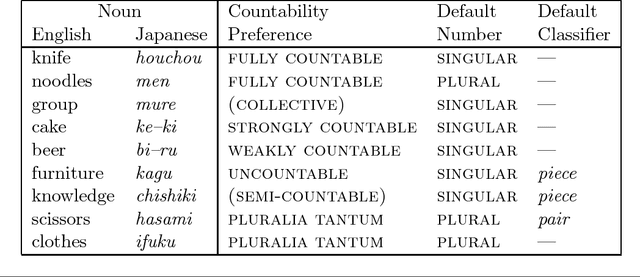Kentaro Ogura
NTT
Temporal Expressions in Japanese-to-English Machine Translation
Aug 28, 2000
Abstract:This paper describes in outline a method for translating Japanese temporal expressions into English. We argue that temporal expressions form a special subset of language that is best handled as a special module in machine translation. The paper deals with problems of lexical idiosyncrasy as well as the choice of articles and prepositions within temporal expressions. In addition temporal expressions are considered as parts of larger structures, and the question of whether to translate them as noun phrases or adverbials is addressed.
* 8 pages, slightly reformatted to avoid obscure style file
Classifiers in Japanese-to-English Machine Translation
Aug 21, 1996
Abstract:This paper proposes an analysis of classifiers into four major types: UNIT, METRIC, GROUP and SPECIES, based on properties of both Japanese and English. The analysis makes possible a uniform and straightforward treatment of noun phrases headed by classifiers in Japanese-to-English machine translation, and has been implemented in the MT system ALT-J/E. Although the analysis is based on the characteristics of, and differences between, Japanese and English, it is shown to be also applicable to the unrelated language Thai.
* 6 pages, LaTeX, uses gb4e.sty, fullname.bst
Noun Phrase Reference in Japanese-to-English Machine Translation
Jan 23, 1996
Abstract:This paper shows the necessity of distinguishing different referential uses of noun phrases in machine translation. We argue that differentiating between the generic, referential and ascriptive uses of noun phrases is the minimum necessary to generate articles and number correctly when translating from Japanese to English. Heuristics for determining these differences are proposed for a Japanese-to-English machine translation system. Finally the results of using the proposed heuristics are shown to have raised the percentage of noun phrases generated with correct use of articles and number in the Japanese-to-English machine translation system ALT-J/E from 65% to 77%.
Possessive Pronouns as Determiners in Japanese-to-English Machine Translation
Jan 23, 1996


Abstract:Possessive pronouns are used as determiners in English when no equivalent would be used in a Japanese sentence with the same meaning. This paper proposes a heuristic method of generating such possessive pronouns even when there is no equivalent in the Japanese. The method uses information about the use of possessive pronouns in English treated as a lexical property of nouns, in addition to contextual information about noun phrase referentiality and the subject and main verb of the sentence that the noun phrase appears in. The proposed method has been implemented in NTT Communication Science Laboratories' Japanese-to-English machine translation system ALT-J/E. In a test set of 6,200 sentences, the proposed method increased the number of noun phrases with appropriate possessive pronouns generated, by 263 to 609, at the cost of generating 83 noun phrases with inappropriate possessive pronouns.
Countability and Number in Japanese-to-English Machine Translation
Nov 03, 1995



Abstract:This paper presents a heuristic method that uses information in the Japanese text along with knowledge of English countability and number stored in transfer dictionaries to determine the countability and number of English noun phrases. Incorporating this method into the machine translation system ALT-J/E, helped to raise the percentage of noun phrases generated with correct use of articles and number from 65% to 73%.
* 7 pages, LaTeX, uses twocolumn.sty, 11pt, lsalike.sty, gb4e.sty
 Add to Chrome
Add to Chrome Add to Firefox
Add to Firefox Add to Edge
Add to Edge